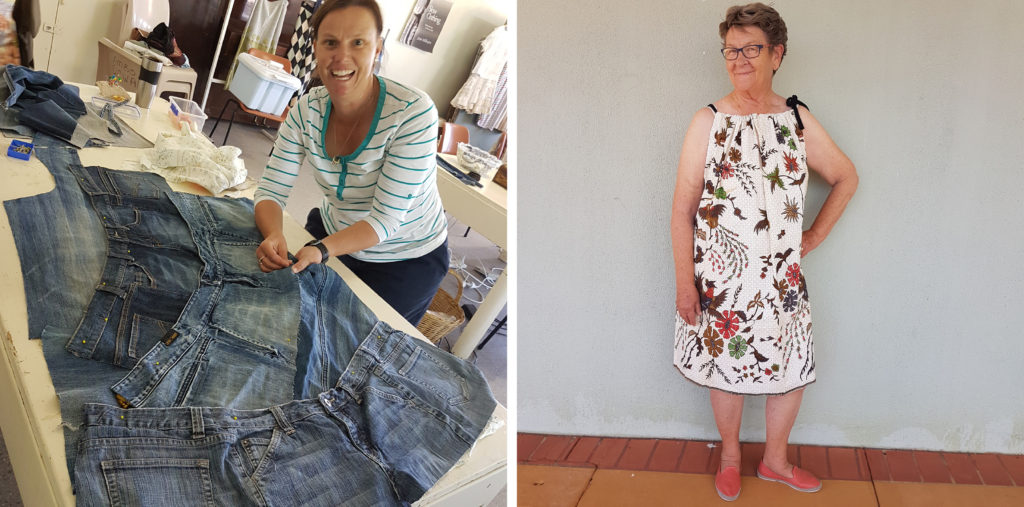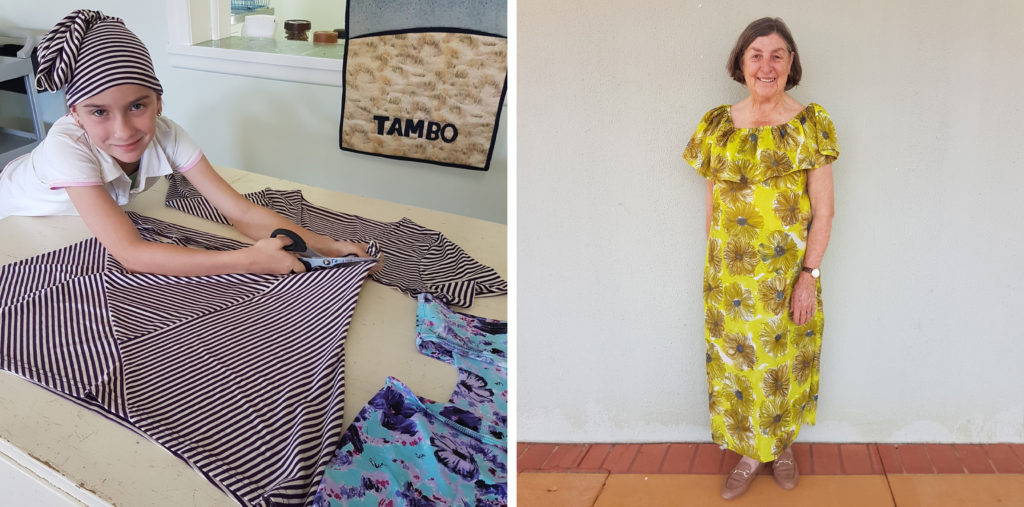Who wants our waste, our rubbish and our cast-offs? Last year’s news was China rejecting our recycled materials, this year’s news is charity shops being so overwhelmed they called a temporary halt to donations. It is time for a serious rethink on stuff.
When we go camping or on holidays we realise how little stuff we really need. At home we may have wardrobes full of garments while studies show we only actively wear about 20 percent of them.
Marie Kondo, The Minimalists and others have turned stuff management into a profession as everyday people become overwhelmed with possessions that are ultimately of little value.

Melissa Iland and Jenny Donaldson upcycling at CWA Tambo, reviving existing natural-fibre resources for fun, creativity and as a hands-on local response to sustainability and climate change.
We often feel pressured into buying stuff we don’t need, or are gifted things we don’t want or like, all in the name of keeping the economy growing and celebration of the good life.
Yet we have lived experience of how our world is changing – scorching temperatures and irregular rainfalls, fish kills in our river systems and scientists indicating we have only 12 years to stop irredeemable climate change.
We need to ‘be the change’ and know that every little action we take can make a difference. If everyone does something, that adds up to a lot. Australians annually generate on average 2.7 tonnes of waste per person, so there’s plenty of room for improvement.
We can do more recycling and reusing for ourselves, recreating what we have to keep it in circulation. Perhaps even wear clothes out! Who does that anymore, wear something until it is threadbare then put it in the garden to compost? If you’re wearing natural fibres, they will decompose back to organic matter within 12 months. Synthetic materials like polyester and nylon take decades or centuries to breakdown, but that’s another story.
In society today, virtually all our needs are outsourced to specialists. As Michael Pollan writes in Cooked – we outsource our meals to the food industry, our health to the medical profession, our entertainment to Hollywood and our clothing needs to the fashion industry (I added the last one).
The problem with this division of labour in a complex economy is that it obscures the lines of connection and therefore of responsibility between our everyday acts and their real-world consequences.
This manifests itself in imported clothing being unrealistically cheap because there is slavery in global supply chains, which may or may not be circumvented by the Modern Slavery Bill passed by the Australian Government late last year.
While there are no easy solutions to climate change or slavery, we can stop buying into and exacerbating both these issues by reusing what we already have to hand.
Simply ‘start where you are, use what you have, do what you can’ as athlete Arthur Ashe famously said. We do not need the planets to align before we begin upcycling. We just begin, using what we have in front of us.
And so it was at CWA Tambo late last year when branch member Jan Ross ‘Byrgenna’ organised slow clothing sessions after securing a grant from the Queensland Government’s Regional Arts Development Fund.
At these sessions, we used resources to hand – including fabric dormant in sewing cupboards, once-were-favourite garments now hanging in the back of the wardrobe and natural-fibre items from the 50c rack at opshops.
Such resources are just one step away from becoming landfill, ideal for learning and experimenting without fear because we are not economically invested in the outcomes.
While her mum Melissa upcycled old jeans into a denim pinny, Zanthea Iland, aged 11, honed her sewing machine and hand-stitching skills upcycling a 50c opshop remnant, a 50c t-shirt and two skimpy dresses to produce three great looks.
Jenny Donaldson turned an old linen jacket and t-shirt into a dress, transformed a tablecloth into a shift dress, and used eucalyptus leaves to enliven white remnants.
There was more going on than these immediate outcomes. As we make, we have conversations about clothing culture and habits, about ways of living more mindfully and sustainably. We talk about reusing resources and reducing waste, about mistakes sparking creative problem-solving opportunities, about convenience culture and mending.
My book Slow Clothing: finding meaning in what we wear reflects on why and how we can change the way we dress to live lightly on Earth and is based on six years of action research, including hundreds of talks and workshops such as these.
Sewing, stitching and mending are traditional skills many CWA members have, including my Brisbane City Nights branch, and we apply them in a modern context through upcycling – which is not actually a new concept, it is old becoming new again.
In a world overflowing with existing resources, taking a little time to recreate and reflect is time well spent. Why bother you say? We bother because making something with our own hands gives us connection to what we wear. Without this connection and an understanding of how clothes are made, we cannot appreciate the effort time and resources that go into the clothes we buy.
Commenting on the Tambo sessions, CWA Queensland President Christine King said: ‘These are great workshops, we need them in all the divisions. With the War on Waste and a scarcity of natural resources, we need to be identifying ways that CWA can contribute beyond our comfortable space. I’d love it if all divisions got more involved in upcycling and creative reuse of fabric resources.’
- This article by Jane Milburn was first published in the Autumn 2019 issue of Ruth Magazine
